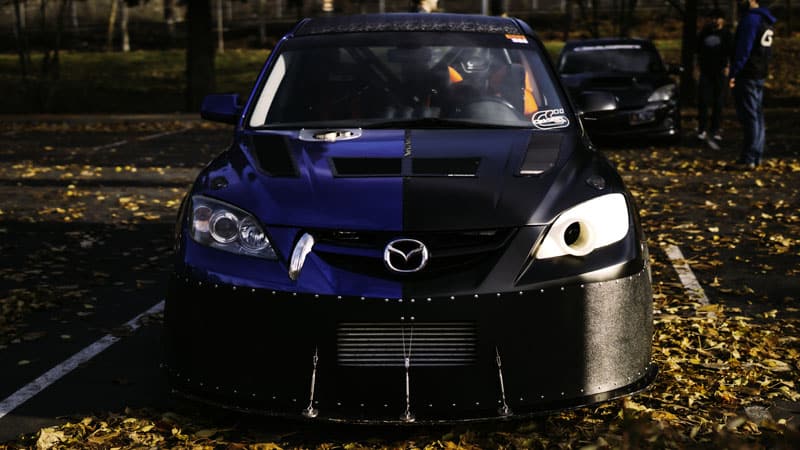Welcome to part 4 of the Mazdaspeed3 AWD Swap! If you missed the previous posts, you can catch the Intro, (Part 2), and Part 3. This blog will cover the rear suspension design, specifically the rocker arms, and how we came to the size, shape, and overall design. This will get technical with numbers, angles, and CAD models.
Before we get into the technical jargon, let’s cover the “what” with rocker arm suspension.
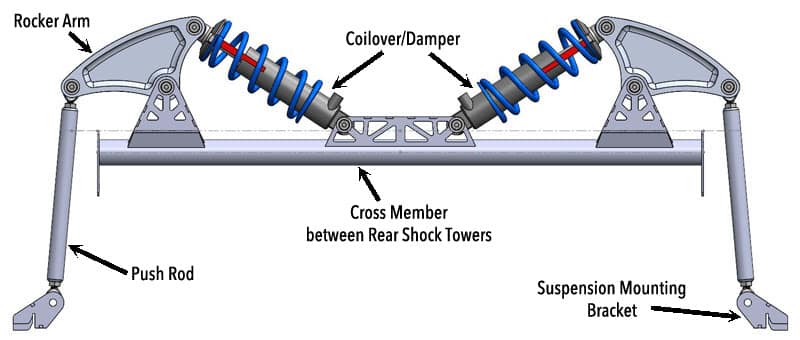
Let’s break down this diagram as it is 100% not OEM for the Mazdaspeed 3:
- Rocker Arm: This is the keystone of the suspension design and does all the work. The rocker arm connects the push rod and the damper to transfer suspension force at a different angle. The rocker arms can also go by a few names: rocker arm, bell crank, cantilever, and pivot arm, to name a few.
- Push Rod: This is a simple rod with spherical rod ends on each end. This connects the OEM suspension to the rocker arm. The push rod is in a similar location as the OEM suspension.
- Suspension Mounting Bracket: This is the mounting point for the push rod to the OEM suspension trailing arm. This must be added because the OEM damper mount is below the now-new axle shaft.
- Coilover/Damper: This is an off-the-shelf damper that can have a coil spring installed on it. It features independent rebound and compression damping adjustability.
- Cross Member: This is the cross member that is welded between the chassis shock towers in the car to support the new rocker arm suspension.
Here you can see the design tack welded in the car. This should help you understand how the design fits and is used in the car itself.
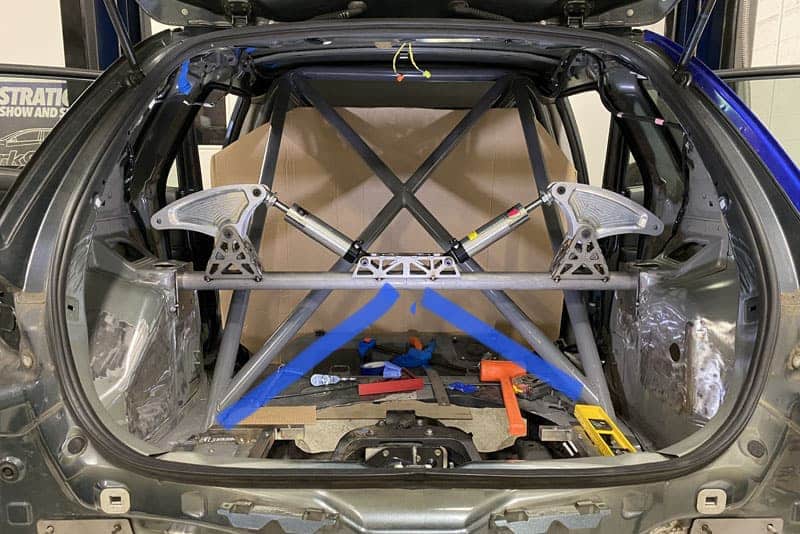

Now that we have a basic understanding of this rocker arm-style suspension let’s get into some more details!
First, let’s talk about suspension and the forces they deal with. Gravity pushes you and your car down to the ground, and road imperfections (bumps, potholes, unlevel surfaces) try to push you and your car up/down/all around while driving. If vehicles did not have suspension and instead the wheels were rigidly attached to the vehicle chassis, we would have all sorts of issues. Comfort, control, and tractions are the big concerns, amongst many others.
The suspension’s job is to soak up and move with many road imperfections like bumps, potholes, and unlevel surfaces. Every time your tire goes over a bump or pothole, it moves up or down, resulting in a force transferred into the suspension.
Check out this quick illustration to see the rocker arm suspension in motion:
As the tire moves up/down, you can see that the rocker arm pivots and transfers that motion into the coilover/damper.
Now let’s break down those forces a bit more. The rocker arm allows us to change the angle of the forces transferred to a new angle that is easier for us to deal with. Instead of being required to have a coilover/damper in a vertical suspension down around the tire (like OEM), I can now change the angle so I can put the coilover/damper in a position that is much easier to deal with.
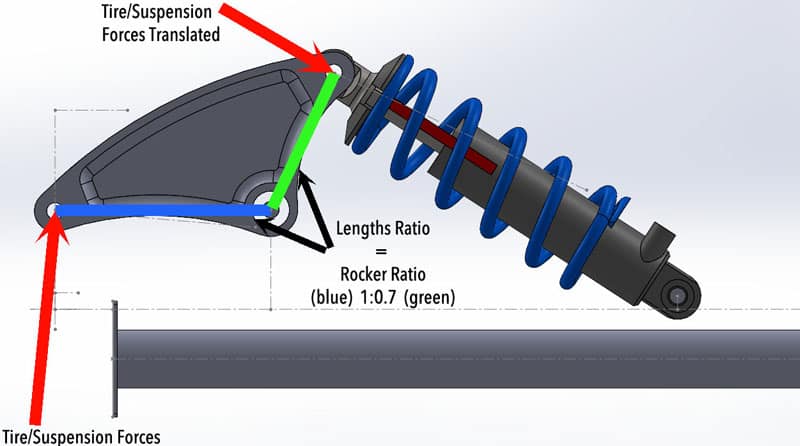
The rocker arm has two major features about it.
- The angle change of transferred forces, as we just discussed. This is mainly to help with “positioning” the suspension components.
- The rocker arm lengths allow us to define the “motion ratio” of the suspension. Looking at the diagram, you can see a blue line and a green line. These effective rocker arm lengths affect the suspension and result in a motion ratio.
- The resulting ratio is 1:0.7 meaning the damper compresses 70% of the amount that the wheel moves up/down.
- The wheel/tire has a maximum range of 5.55 inches of travel, while the damper has a maximum travel of 3.875 inches.
Designing the rocker arm with this 1:0.7 motion ratio allowed me to use a smaller, lighter damper design with limited travel and still get the desired wheel suspension travel I needed. We use a stiffer spring to compensate for the extra leverage of the motion ratio.
Motion ratios in suspension are common. For example, the Mazdaspeed 3 suspension has a unique motion ratio in the front (1:0.98) and rear (1:0.71) from our calculations. These numbers are typical of the style of suspension found in many commuter cars these days.
Now that we understand the forces and the intent with the rocker am…we have to design its shape and size to do the job. Angles are the tricky parts of the rocker arm design. Defining the angles (and thus shape) comes down to understanding the push rod input angles and the desired damper output angles while in motion.
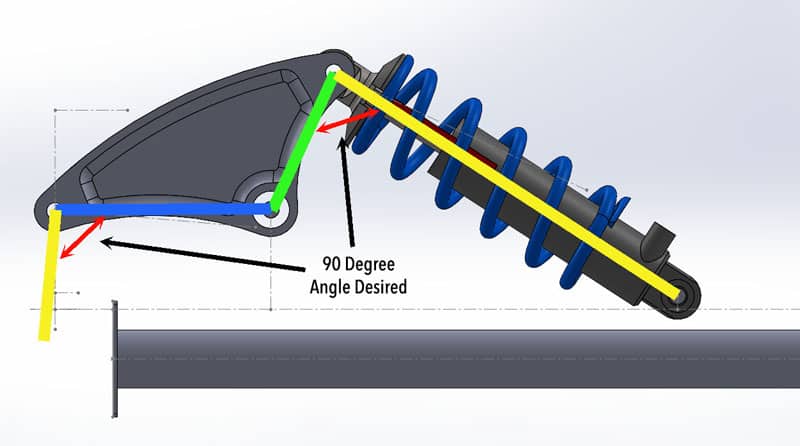
When we say “angles,” we are talking about the red arrows in the above diagram. These red arrows are the angles between the rocker arm and the push rod, as well as the rocker arm and the damper. Ideally, these angles are always 90 degrees through the entire motion you see in the GIF, but that is not physically possible, so we had to find the correct balance of angles while in motion.
A whole lot of math encompasses this, but the upcoming diagrams will help break it down to a very understandable level for everyone! We are breaking it down to the three major suspension travel points: droop, bump and ride height.
First, we are going to look at the angles for the push rod in Bump, Ride Height, and Droop.
- Bump is when the suspension is fully compressed.
- Ride Height is when the car is sitting stationary (static).
- Droop is when the suspension is fully decompressed. Image your car sitting on jack stands with the tires hanging in the air.
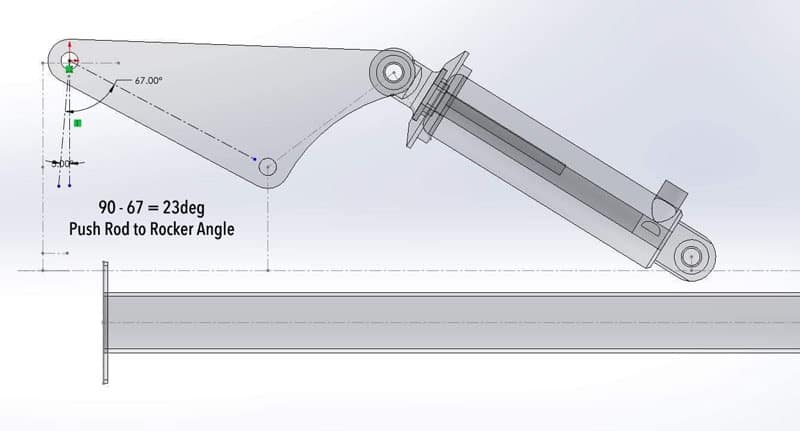
In full bump, the push rod angle to the rocker arm decreases to 67 degrees which is 23 degrees off the “ideal” 90.

Then looking at ride height as the suspension moves downward from full bump. The damper-to-rocker arm angle decreases to 82 degrees which is 8 degrees off the “ideal” 90.
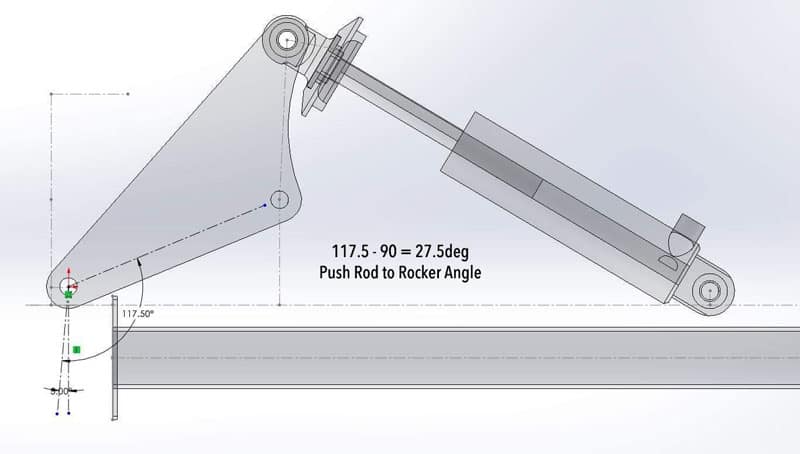
Lastly, with the suspension traveling to full droop. The push rod to rocker arm angle increases to 117.5 degrees which is 27.5 degrees off the “ideal” 90.
What does this mean? This is great, actually! Ride height is where the suspension will function most of the time, and that is only 5 degrees off the ideal 90-degree angle. When the car is launched in a drag race, the suspension is going to compress, and that angle will decrease, passing through the ideal 90-degree angle and further. This is precisely the balance we are looking for with the rocker arm design. To keep it functioning most of the time as close to 90 degrees as possible.
Ok, let’s look at the angles from the damper side of the rocker arm.
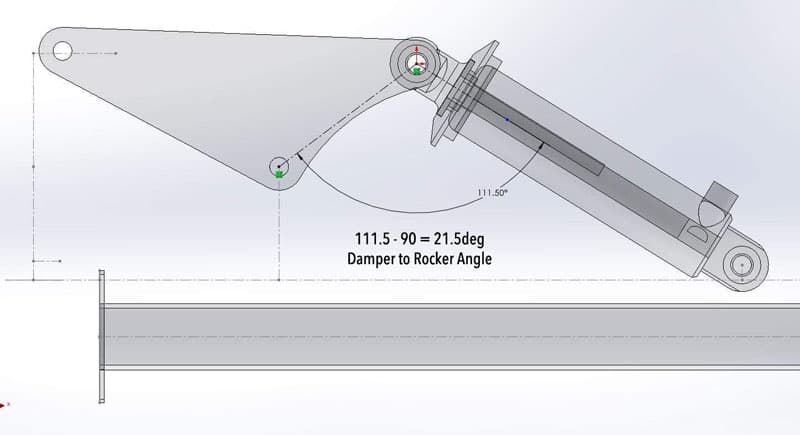
In full bump, the damper angle to the rocker arm increases to 111.5 degrees which is 21.5 degrees off the “ideal” 90.
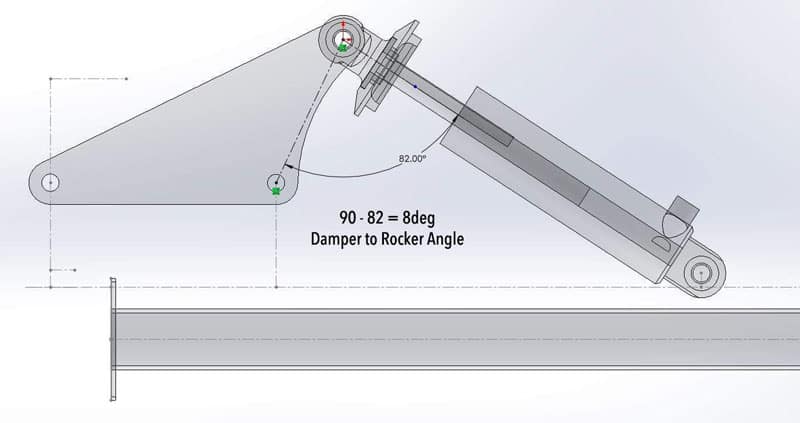
Then looking at ride height as the suspension moves downward from the full bump. The damper-to-rocker arm angle decreases to 82 degrees which is 8 degrees off the “ideal” 90.
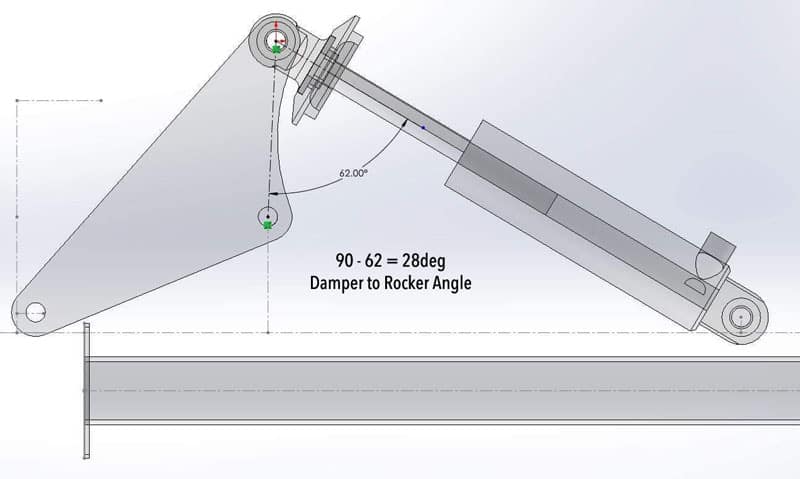
With the suspension traveling to full droop, the damper-to-rocker arm angle decreases to 62 degrees which is 28 degrees off the “ideal” 90.
Again we have the damper near the “ideal” 90-degree angle at ride height and then pass through the 90-degree angle zone when the suspension compresses at launch. Again, the balanced angles we are trying to design for so the suspension function in the “ideal” angle range most of the time.
Why are the angles so important? The further you get from the “ideal” 90-degree angle, the more non-linear the suspension acts. When the suspension acts in a linear function, it is tunable and predictable to drive. If it is non-linear, then it makes tuning and use much more difficult…this results in inconsistent launching and driving, which is not good in a racing environment.

This seems like a lot of work…why do it?
A few reasons, really:
- Moving to the rocker arm design gave me a lot of control over how I set up my Mazdaspeed for racing.
- It also gave me the ability to use readily available off-the-shelf dampers. This allowed me to get double adjustable dampers (rebound and compressor) for a very cost-effective price.
- The CX7 AWD swap rear axle shafts did not allow me to use the OEM dampers anyways.
- This design moves more of the suspension component’s weight to “sprung mass” which is better.
- I love the challenge of designing a suspension system like this, and this was a great opportunity!
Before we wrap things up, note the rocker arms are 6061-T6 billet and are massive! We knew they were big, but it didn’t really sink in until we saw them firsthand.
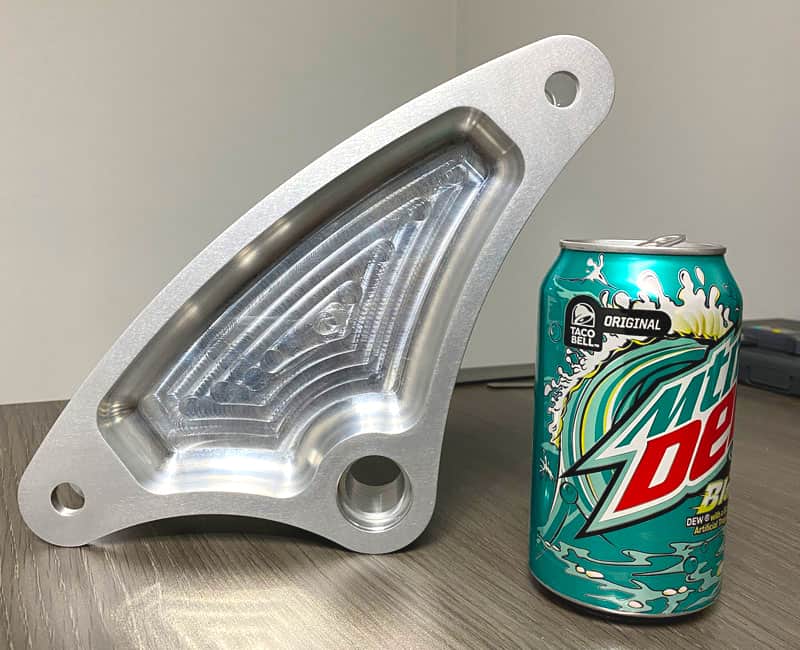
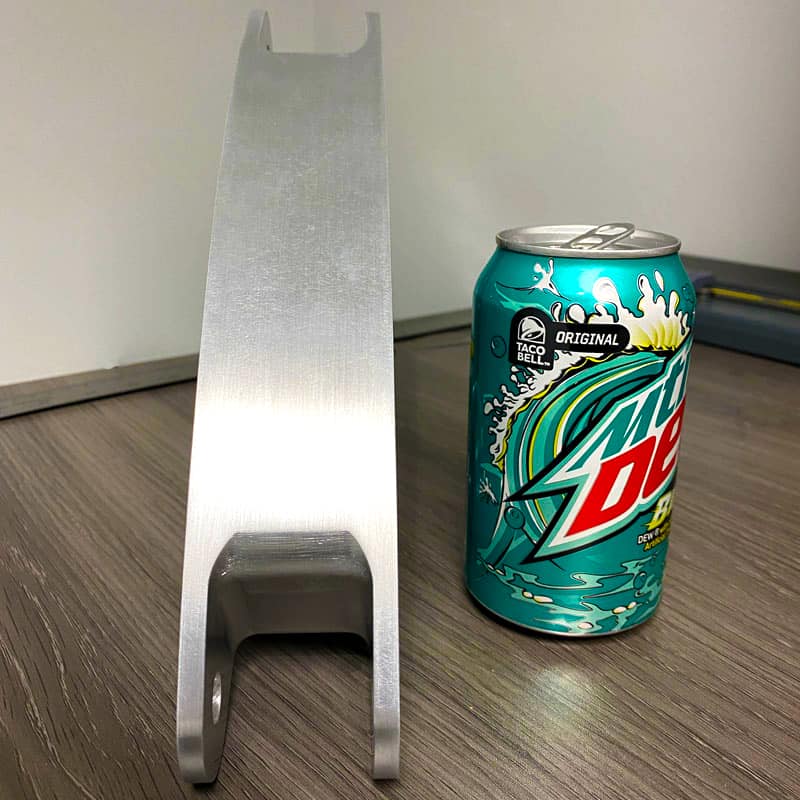
Alright, that wraps up the rocker arm suspension design, a huge novelty for the build. There are plenty more huge milestones to overcome, and those are coming up in this multi-part blog series!
I hope you are enjoying this series about the AWD Swap Mazdaspeed3, stay tuned for more blogs to come!
You can also find updates on my IG @halfmilespeed3, the CorkSport 7th Gear Membership, and on mazdaspeeds.org.
Thanks for tuning in!
-Barett @ CS
Connect with us:
You may also like:


